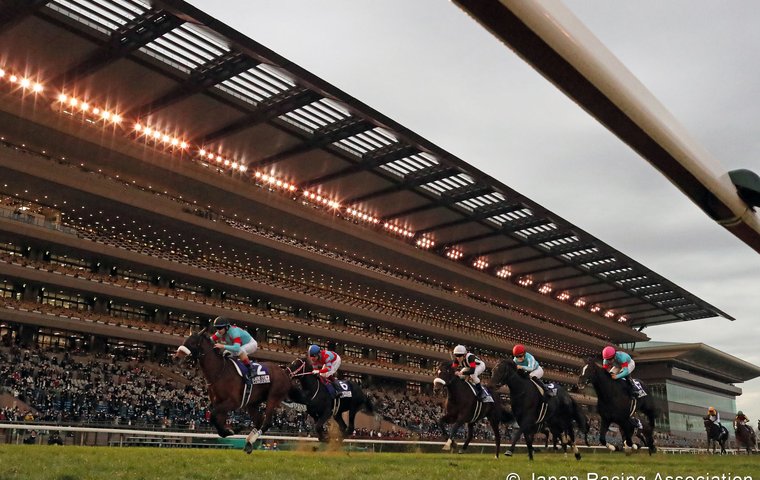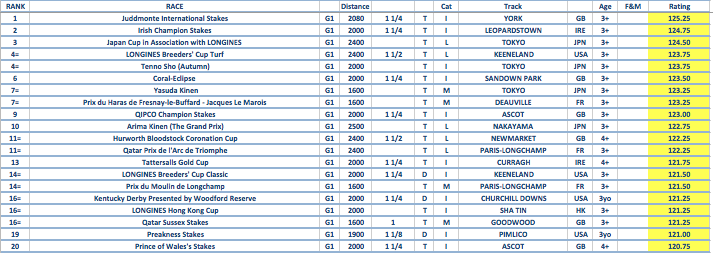
The Japan Cup last November was the best race in the world in 2020, according to the new TRC Computer Race Ratings. That is one of many notable differences in our list, published below, compared with the equivalent rankings from the IFHA (International Federation of Horseracing Authorities).
The mile-and-a-half Tokyo showpiece was won by the now-retired Almond Eye from Triple Crown winners Contrail and Daring Tact and ten other Graded-race winners, five of them successful in G1s (including one in a top-flight race in France and another in one in Hong Kong).
Right behind it as the second-best race of the year is another Tokyo contest won by Almond Eye - the two-furlong-shorter Tenno Sho (Autumn) run just four weeks before the Japan Cup. The mare won that from three-time G1 winners Fierement and Chrono Genesis and four others with G1s to their name.
No wonder the 9-time G1 winner ended the year as #1 in the TRC Global Horse Rankings, a position she is likely to hold for another few weeks until the 180-day rule kicks in (the computer drops individuals from our published rankings if they have not competed in Group/Graded events for 180 days).
TRC’s 20 best races of 2020 worldwide
The inaugural running of the G1 Saudi Cup emerged as the third-best race of the year. It is not included in the IFHA list, which ranks only G1s. However, as is the case with a number of races, including The Everest at Randwick and the Hong Kong Derby at Sha Tin, we rate it a G1, based on the quality of the field.
The Japan Cup (see video above) is third in the IFHA top 100, behind the Juddmonte International at York (won by Ghaiyyath) and the Irish Champion Stakes at Leopardstown (won by Magical, from Ghaiyyath). TRC Computer Race Rankings has those two races at fourth and joint-seventh respectively.
The IFHA puts the Tenno Sho (Autumn) as joint 4th with the Breeders’ Cup Turf, which means it is rated a better race than the Breeders’ Cup Classic (joint 14th). The TRC algorithm can place the BC Turf no higher than 28th, but we have the BC Classic fifth.
IFHA’s top 20 races of 2020
The IFHA race ratings are based on the Longines World’s Best Racehorses classification, taken from assessments by handicappers representing member jurisdictions.
TRC Computer Race Ratings are drawn from thousands and thousands of form lines connecting horses around the world. You may not think there can be many if any links between, say, a mile race in Australia and a ten-furlong event in Ireland or a seven-furlong contest on dirt in North America, but there is invariably a spider’s web of connections that make comparisons relatively simple - to a computer.
You can use as many human experts as you can find, but there is no way they can remotely begin to trace so many links manually, and it is a tribute to the IFHA’s team that they produce such diligent work year-in, year-out.
The TRC algorithm is totally objective, totally devoid of bias. It takes zero consideration of the identity of the race or its prize fund. It doesn’t matter if it’s the Arc, the Kentucky Derby, the Melbourne Cup or a G3 at Baden Baden, each is just another horserace to the computer.
How the TRC Computer Race Rating is calculated
Every number we produce that involves the TRC Global Rankings is geared to prediction. There is no other way to optimize ratings than to see how they work out in future races. Humans have no shot to perform such an optimization, but computers are ideally suited for the task.
Computers should be the future of handicapping. There is little doubt about that.
To produce the RaceRating shown in the table, we use a weighted average of the ratings produced by the first five finishers in the race, plus the weighted average of their best career ratings – taking into account the difference between the race being rated and the date of the horse’s best effort; this makes sense because the less recent is a horse’s best effort, the more uncertainty exists as to whether the horse can produce it.
Why do we do it this way when the IFHA use a much simpler method? Once again, it is down to predictive power. If you assign the winner of each race the RaceRating we have calculated using the above method, then rate horses down the field a lesser number according to how far they were beaten, it yields the most number of future winners.
When the field-size is less than five runners, we use slightly different weights to calculate the strength of the race. This has the effect of reducing the RaceRating in races with small fields, such as Enable’s win in the three-runner G1 King George at Ascot.
One of the many advantages of computing race ratings using the TRC method is that ratings are constantly revised and updated each week, according to how the form is working out. And any change to the way we rate races can instantly be measured for its efficacy by calculating the number of future winners it produces.
Human handicappers simply do not have this information.




